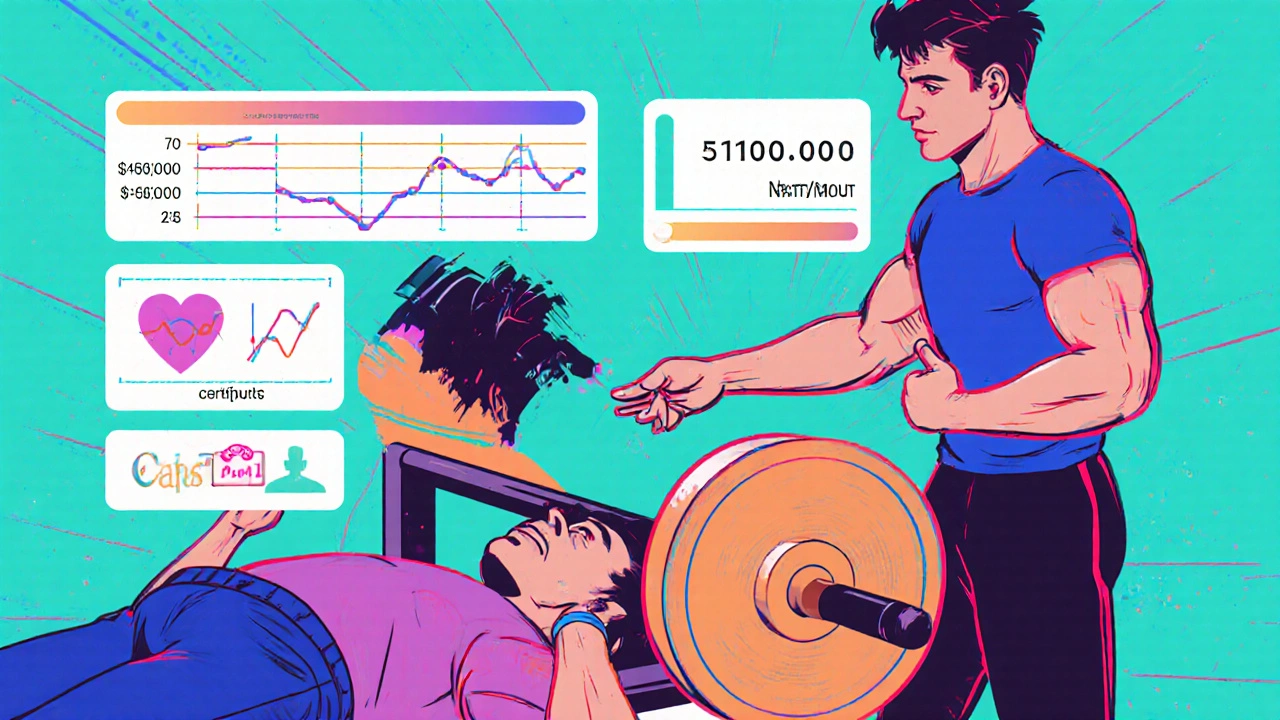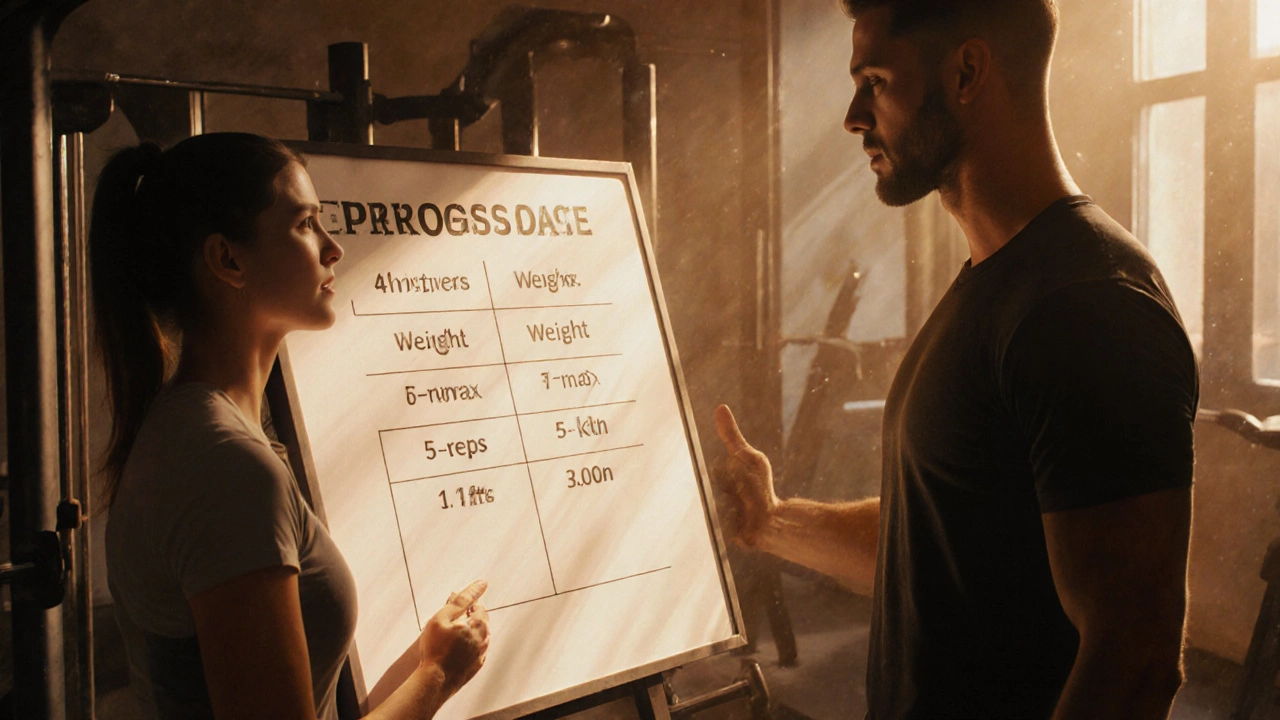Can One Month of Personal Training Deliver Real Results?
 Oct, 24 2025
Oct, 24 2025
Personal Training Progress Estimator
Estimate realistic improvements after 4 weeks of personal training based on your starting metrics.
Note: These estimates are based on the article's data about realistic 4-week outcomes. Results vary based on individual factors including nutrition, sleep, and session frequency.
Quick Takeaways
- A well‑structured 4‑week personal training plan can boost strength and confidence, but major body‑composition changes usually need more time.
- Results depend on trainer expertise, session frequency, nutrition, sleep and how consistently you follow the program.
- Tracking progress with measurable data (weight, reps, heart‑rate zones) turns vague goals into concrete milestones.
- If you hit a plateau after the first month, extending the partnership or adding self‑guided workouts keeps momentum going.
- Set realistic expectations: expect skill acquisition and neural adaptations in 4 weeks, not dramatic muscle size gains.
When you sign up for a personal training package, the first question that pops up is “Is 1 month enough?” It’s a tempting thought - a short‑term commitment, a quick price tag, and the promise of fast results. The truth sits somewhere in the middle. Below we break down what the body can realistically achieve in four weeks, the variables that tip the scale, and how to make those 30 days count.
Personal Training is a one‑on‑one fitness service where a certified professional designs, monitors, and adjusts exercise programs to match an individual’s goals, abilities, and lifestyle. In a typical one‑month package you’ll get anywhere from two to five sessions per week, a customized workout plan, and ongoing feedback. Let’s unpack what that usually looks like.
What a One‑Month Personal Training Package Usually Includes
- Initial assessment - body‑composition measurement, movement screening, and goal setting.
- Tailored program - a mix of Strength Training resistance exercises aimed at increasing muscular force and Cardiovascular Exercise activities that raise heart rate and improve aerobic capacity.
- Progress tracking - weekly weight, rep maxes, heart‑rate zones, or body‑fat percentage.
- Education - nutrition basics, recovery strategies, and habit formation tips.
- Adjustments - a trainer revises the plan based on performance data and how you feel.
Most gyms bundle these elements into a four‑week sprint, promising measurable improvements. But how fast does the body actually adapt?
How Quickly Can Your Body Adapt?
In the first weeks, the majority of strength gains come from neural adaptations - your brain learns to recruit muscle fibers more efficiently. This translates to a noticeable bump in the amount you can lift, even if muscle size (hypertrophy) hasn’t changed much yet.
On the cardio side, your cardiovascular system improves via increased stroke volume and better oxygen utilization. You’ll likely notice you can jog a bit farther before feeling winded.
Key physiological concepts to understand:
- Hypertrophy muscle‑fiber growth that usually becomes noticeable after 6‑8 weeks of consistent resistance training - not fully realized in 4 weeks.
- Metabolic Rate the calories your body burns at rest, which can rise slightly from increased muscle mass and activity level - modest changes in a month.
- Recovery the process of repairing muscle tissue and replenishing energy stores, heavily influenced by sleep and nutrition - essential for any gains.

Realistic Goals for a Four‑Week Timeline
What can you truly expect after a month of dedicated coaching?
| Outcome | 4‑Week Expectation | 8‑Week Expectation |
|---|---|---|
| Strength (e.g., bench press) | 5‑10% increase (neural gain) | 15‑20% increase (includes early hypertrophy) |
| Body‑Fat Reduction | 0‑2% decrease (depends on diet) | 3‑5% decrease |
| Endurance (run 5 km) | 10‑15% faster time | 20‑30% faster time |
Notice the pattern: early gains are mostly about efficiency and skill, while visible changes in muscle size or fat loss need longer exposure.
Factors That Influence Whether One Month Is Enough
Even the same program can produce wildly different results based on these variables:
- Trainer expertise. A Certified Personal Trainer a fitness professional who has earned a recognized certification and adheres to continuing‑education standards can personalize intensity, troubleshoot form, and keep you motivated.
- Session frequency. Two sessions a week will yield slower progress than five, assuming recovery is adequate.
- Nutrition. Calories, protein intake, and timing fuel both strength and recovery. Skipping this column kills results.
- Sleep and stress. Less than 7 hours of sleep can blunt muscle‑protein synthesis and raise cortisol, which hampers fat loss.
- Baseline fitness. Beginners often see larger proportional gains because their bodies are far from adapted.
- Goal specificity. Trying to lose 10 kg and run a marathon simultaneously in 30 days is unrealistic.
Sample 4‑Week Plan Overview
Here’s a snapshot of what a balanced month might look like. Adjust the weight, reps, and cardio length to suit your current level.
- Monday - Upper‑Body Strength: 4 sets of 6‑8 reps (bench press, rows, overhead press). Finish with 10 min of HIIT cardio.
- Tuesday - Mobility & Core: 45 min of dynamic stretching, plank variations, and balance drills.
- Wednesday - Lower‑Body Strength: 4 sets of 8‑10 reps (squat, deadlift, lunges). Follow with 15 min steady‑state bike.
- Thursday - Rest or Light Active Recovery: 30‑min walk, foam rolling.
- Friday - Full‑Body Circuit: 3 rounds of 12‑15 reps across major lifts, minimal rest, finish with 5 min sprint intervals.
- Saturday - Cardio Endurance: 30‑45 min jog or swim at moderate intensity.
- Sunday - Free Day: optional yoga or complete rest.
Every week the trainer would slightly increase load or volume, a principle known as Periodization systematic planning of training cycles to optimize performance and avoid plateaus. This ensures you’re always nudging the body into a new adaptation zone.

How to Track Progress Effectively
Measuring success is half the battle. Choose at least two objective metrics and one subjective feeling.
- Body‑Composition. Use skin‑fold calipers or bio‑electric impedance to log fat vs. lean mass.
- Strength Benchmarks. Record a 5‑rep max for major lifts at weeks 1, 3, and 4.
- Endurance Markers. Time a 5‑km run or note the distance covered in a 20‑minute bike test.
- Energy Levels. Simple daily journal entries about fatigue, mood, and soreness.
When you see numbers moving in the right direction, even if they’re small, confidence builds and the habit sticks.
When One Month Isn’t Enough - Next Steps
If after four weeks you’ve hit a plateau or the results feel modest, don’t think the program failed. Instead, treat the first month as a foundation.
- Extend the coaching partnership. Add another 4‑6 weeks with the same trainer, focusing on progressive overload.
- Transition to a hybrid model. Keep two trainer‑led sessions per week while you self‑manage the other days using the program you built.
- Re‑evaluate goals. Maybe shift from pure fat loss to strength or vice‑versa, aligning expectations with realistic timelines.
- Incorporate new modalities. Add kettlebell circuits, yoga for mobility, or HIIT classes to keep the stimulus fresh.
Remember, consistency over months trumps intensity over a single month.
Bottom Line: Is 1 Month Enough?
The short answer: you’ll see improvement, but dramatic transformation usually needs more time. In four weeks you can gain confidence, improve technique, boost neural strength, and lay a solid habit foundation. If your goal is a modest increase in lift numbers, a tighter core, or better cardio endurance, a month of focused personal training can deliver.
For bigger changes - like shedding 5+ kg of fat or adding noticeable muscle size - think of the first month as the launch pad. Pair it with proper nutrition, sleep, and a plan to keep training after the package ends, and the results will keep climbing.
Can I see muscle growth in just four weeks?
Visible hypertrophy usually starts after 6‑8 weeks of consistent resistance work. In four weeks you’ll mainly notice strength gains and better muscle tone.
How many sessions per week are ideal for a 1‑month plan?
Three to five sessions strike a good balance. Two sessions may be too few for rapid progress, while six can risk overtraining if recovery is lacking.
Do I need a special diet during the month?
A balanced diet rich in protein (1.6‑2.2 g/kg body weight), moderate carbs for energy, and healthy fats supports both strength and recovery. Without proper nutrition, gains will be limited.
What if I miss a session?
Missing one or two sessions won’t ruin progress. Communicate with your trainer, who can adjust the weekly volume or add a make‑up workout.
Should I keep training after the month ends?
Absolutely. Use the habit and program you built as a springboard. Many clients transition to a hybrid model: two trainer sessions a month plus self‑directed workouts.
How do I know if my trainer is qualified?
Look for certifications from reputable bodies such as ACSM, NASM, or ACE, and ask about continuing‑education credits. A good trainer will also have client testimonials and clear communication.
